wheel size BMW 650I COUPE 2012 Owners Manual
[x] Cancel search | Manufacturer: BMW, Model Year: 2012, Model line: 650I COUPE, Model: BMW 650I COUPE 2012Pages: 303, PDF Size: 11.32 MB
Page 92 of 303
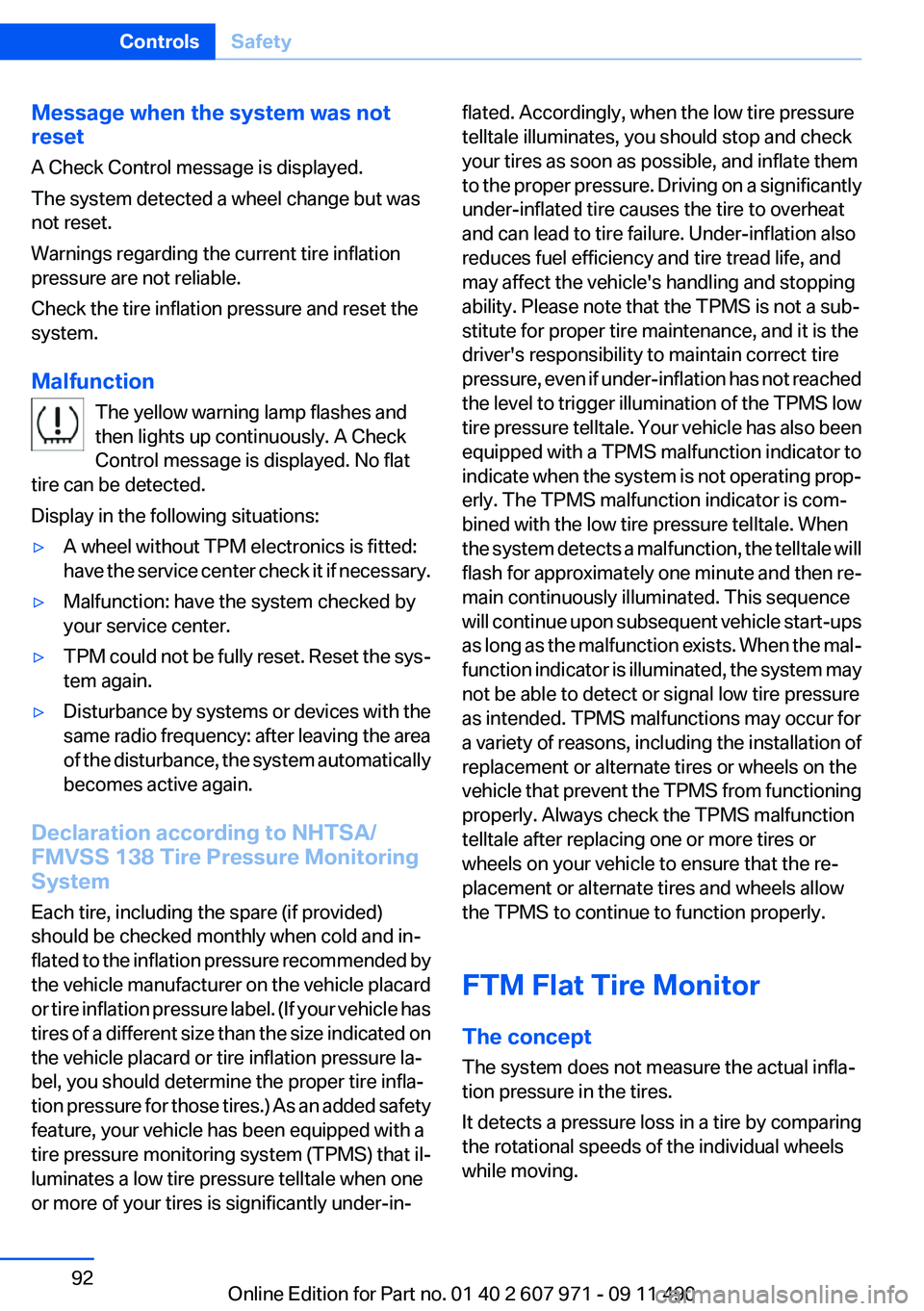
Message when the system was not
reset
A Check Control message is displayed.
The system detected a wheel change but was
not reset.
Warnings regarding the current tire inflation
pressure are not reliable.
Check the tire inflation pressure and reset the
system.
Malfunction The yellow warning lamp flashes and
then lights up continuously. A Check
Control message is displayed. No flat
tire can be detected.
Display in the following situations:▷A wheel without TPM electronics is fitted:
have the service center check it if necessary.▷Malfunction: have the system checked by
your service center.▷TPM could not be fully reset. Reset the sys‐
tem again.▷Disturbance by systems or devices with the
same radio frequency: after leaving the area
of the disturbance, the system automatically
becomes active again.
Declaration according to NHTSA/
FMVSS 138 Tire Pressure Monitoring
System
Each tire, including the spare (if provided)
should be checked monthly when cold and in‐
flated to the inflation pressure recommended by
the vehicle manufacturer on the vehicle placard
or tire inflation pressure label. (If your vehicle has
tires of a different size than the size indicated on
the vehicle placard or tire inflation pressure la‐
bel, you should determine the proper tire infla‐
tion pressure for those tires.) As an added safety
feature, your vehicle has been equipped with a
tire pressure monitoring system (TPMS) that il‐
luminates a low tire pressure telltale when one
or more of your tires is significantly under-in‐
flated. Accordingly, when the low tire pressure
telltale illuminates, you should stop and check
your tires as soon as possible, and inflate them
to the proper pressure. Driving on a significantly
under-inflated tire causes the tire to overheat
and can lead to tire failure. Under-inflation also
reduces fuel efficiency and tire tread life, and
may affect the vehicle's handling and stopping
ability. Please note that the TPMS is not a sub‐
stitute for proper tire maintenance, and it is the
driver's responsibility to maintain correct tire
pressure, even if under-inflation has not reached
the level to trigger illumination of the TPMS low
tire pressure telltale. Your vehicle has also been
equipped with a TPMS malfunction indicator to
indicate when the system is not operating prop‐
erly. The TPMS malfunction indicator is com‐
bined with the low tire pressure telltale. When
the system detects a malfunction, the telltale will
flash for approximately one minute and then re‐
main continuously illuminated. This sequence
will continue upon subsequent vehicle start-ups
as long as the malfunction exists. When the mal‐
function indicator is illuminated, the system may
not be able to detect or signal low tire pressure
as intended. TPMS malfunctions may occur for
a variety of reasons, including the installation of
replacement or alternate tires or wheels on the
vehicle that prevent the TPMS from functioning
properly. Always check the TPMS malfunction
telltale after replacing one or more tires or
wheels on your vehicle to ensure that the re‐
placement or alternate tires and wheels allow
the TPMS to continue to function properly.
FTM Flat Tire Monitor
The concept
The system does not measure the actual infla‐
tion pressure in the tires.
It detects a pressure loss in a tire by comparing
the rotational speeds of the individual wheels
while moving.Seite 92ControlsSafety92
Online Edition for Part no. 01 40 2 607 971 - 09 11 490
Page 245 of 303
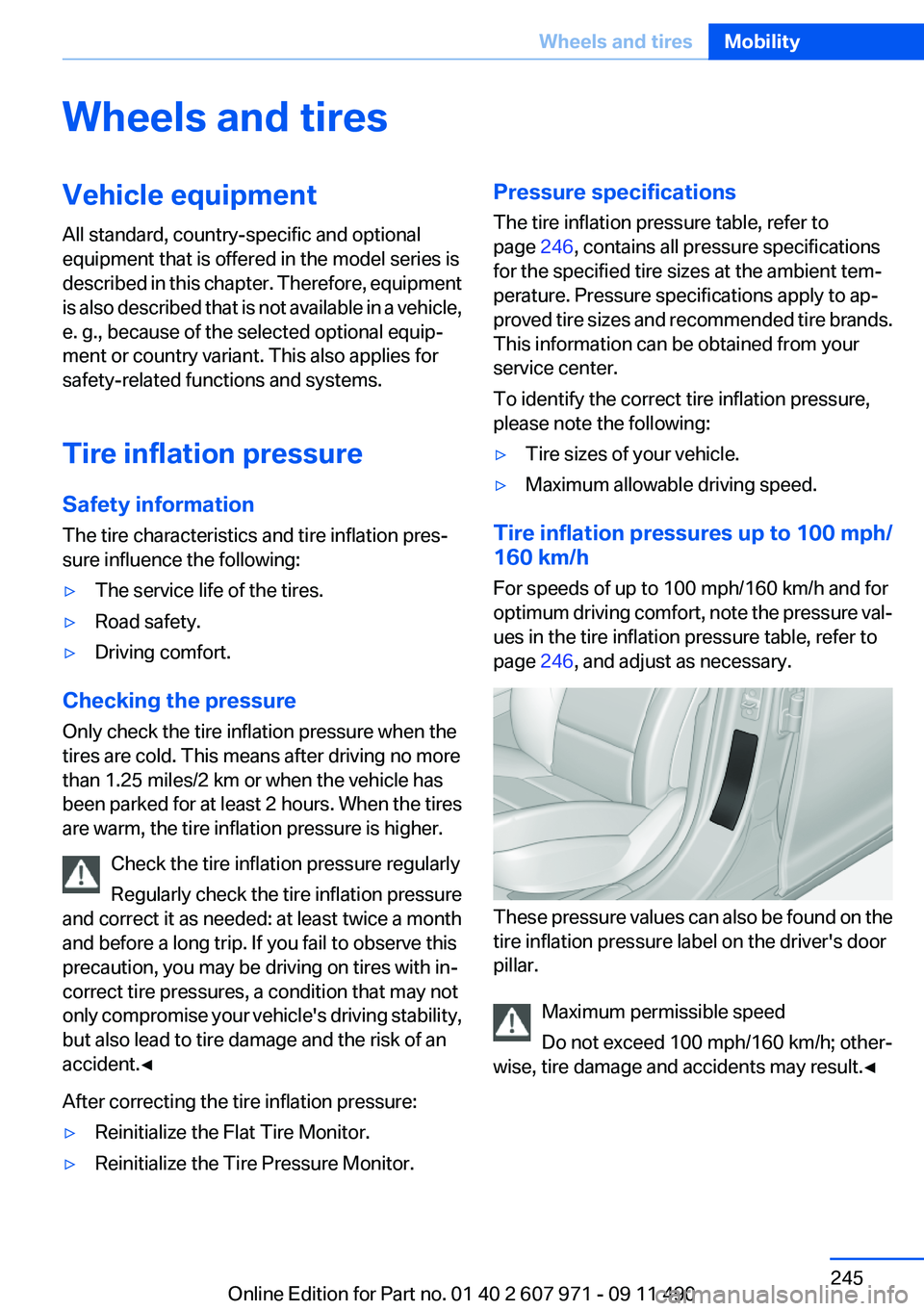
Wheels and tiresVehicle equipment
All standard, country-specific and optional
equipment that is offered in the model series is
described in this chapter. Therefore, equipment
is also described that is not available in a vehicle,
e. g., because of the selected optional equip‐
ment or country variant. This also applies for
safety-related functions and systems.
Tire inflation pressure
Safety information
The tire characteristics and tire inflation pres‐
sure influence the following:▷The service life of the tires.▷Road safety.▷Driving comfort.
Checking the pressure
Only check the tire inflation pressure when the
tires are cold. This means after driving no more
than 1.25 miles/2 km or when the vehicle has
been parked for at least 2 hours. When the tires
are warm, the tire inflation pressure is higher.
Check the tire inflation pressure regularly
Regularly check the tire inflation pressure
and correct it as needed: at least twice a month
and before a long trip. If you fail to observe this
precaution, you may be driving on tires with in‐
correct tire pressures, a condition that may not
only compromise your vehicle's driving stability,
but also lead to tire damage and the risk of an
accident.◀
After correcting the tire inflation pressure:
▷Reinitialize the Flat Tire Monitor.▷Reinitialize the Tire Pressure Monitor.Pressure specifications
The tire inflation pressure table, refer to
page 246, contains all pressure specifications
for the specified tire sizes at the ambient tem‐
perature. Pressure specifications apply to ap‐
proved tire sizes and recommended tire brands.
This information can be obtained from your
service center.
To identify the correct tire inflation pressure,
please note the following:▷Tire sizes of your vehicle.▷Maximum allowable driving speed.
Tire inflation pressures up to 100 mph/
160 km/h
For speeds of up to 100 mph/160 km/h and for
optimum driving comfort, note the pressure val‐
ues in the tire inflation pressure table, refer to
page 246, and adjust as necessary.
These pressure values can also be found on the
tire inflation pressure label on the driver's door
pillar.
Maximum permissible speed
Do not exceed 100 mph/160 km/h; other‐
wise, tire damage and accidents may result.◀
Seite 245Wheels and tiresMobility245
Online Edition for Part no. 01 40 2 607 971 - 09 11 490
Page 246 of 303
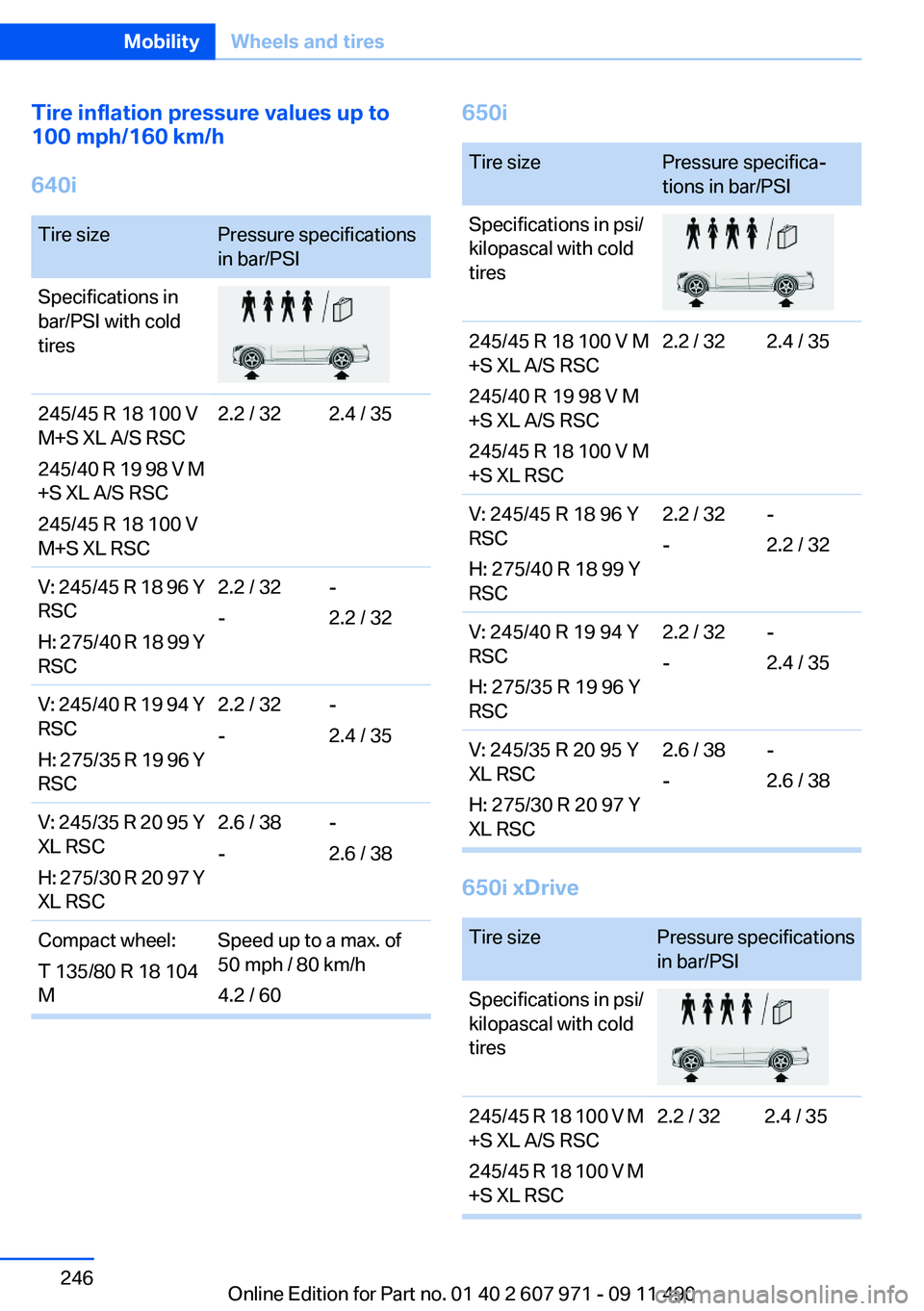
Tire inflation pressure values up to
100 mph/160 km/h
640iTire sizePressure specifications
in bar/PSISpecifications in
bar/PSI with cold
tires245/45 R 18 100 V
M+S XL A/S RSC
245/40 R 19 98 V M
+S XL A/S RSC
245/45 R 18 100 V
M+S XL RSC2.2 / 322.4 / 35V: 245/45 R 18 96 Y
RSC
H: 275/40 R 18 99 Y
RSC2.2 / 32
--
2.2 / 32V: 245/40 R 19 94 Y
RSC
H: 275/35 R 19 96 Y
RSC2.2 / 32
--
2.4 / 35V: 245/35 R 20 95 Y
XL RSC
H: 275/30 R 20 97 Y
XL RSC2.6 / 38
--
2.6 / 38Compact wheel:
T 135/80 R 18 104
MSpeed up to a max. of
50 mph / 80 km/h
4.2 / 60650iTire sizePressure specifica‐
tions in bar/PSISpecifications in psi/
kilopascal with cold
tires245/45 R 18 100 V M
+S XL A/S RSC
245/40 R 19 98 V M
+S XL A/S RSC
245/45 R 18 100 V M
+S XL RSC2.2 / 322.4 / 35V: 245/45 R 18 96 Y
RSC
H: 275/40 R 18 99 Y
RSC2.2 / 32
--
2.2 / 32V: 245/40 R 19 94 Y
RSC
H: 275/35 R 19 96 Y
RSC2.2 / 32
--
2.4 / 35V: 245/35 R 20 95 Y
XL RSC
H: 275/30 R 20 97 Y
XL RSC2.6 / 38
--
2.6 / 38
650i xDrive
Tire sizePressure specifications
in bar/PSISpecifications in psi/
kilopascal with cold
tires245/45 R 18 100 V M
+S XL A/S RSC
245/45 R 18 100 V M
+S XL RSC2.2 / 322.4 / 35Seite 246MobilityWheels and tires246
Online Edition for Part no. 01 40 2 607 971 - 09 11 490
Page 247 of 303
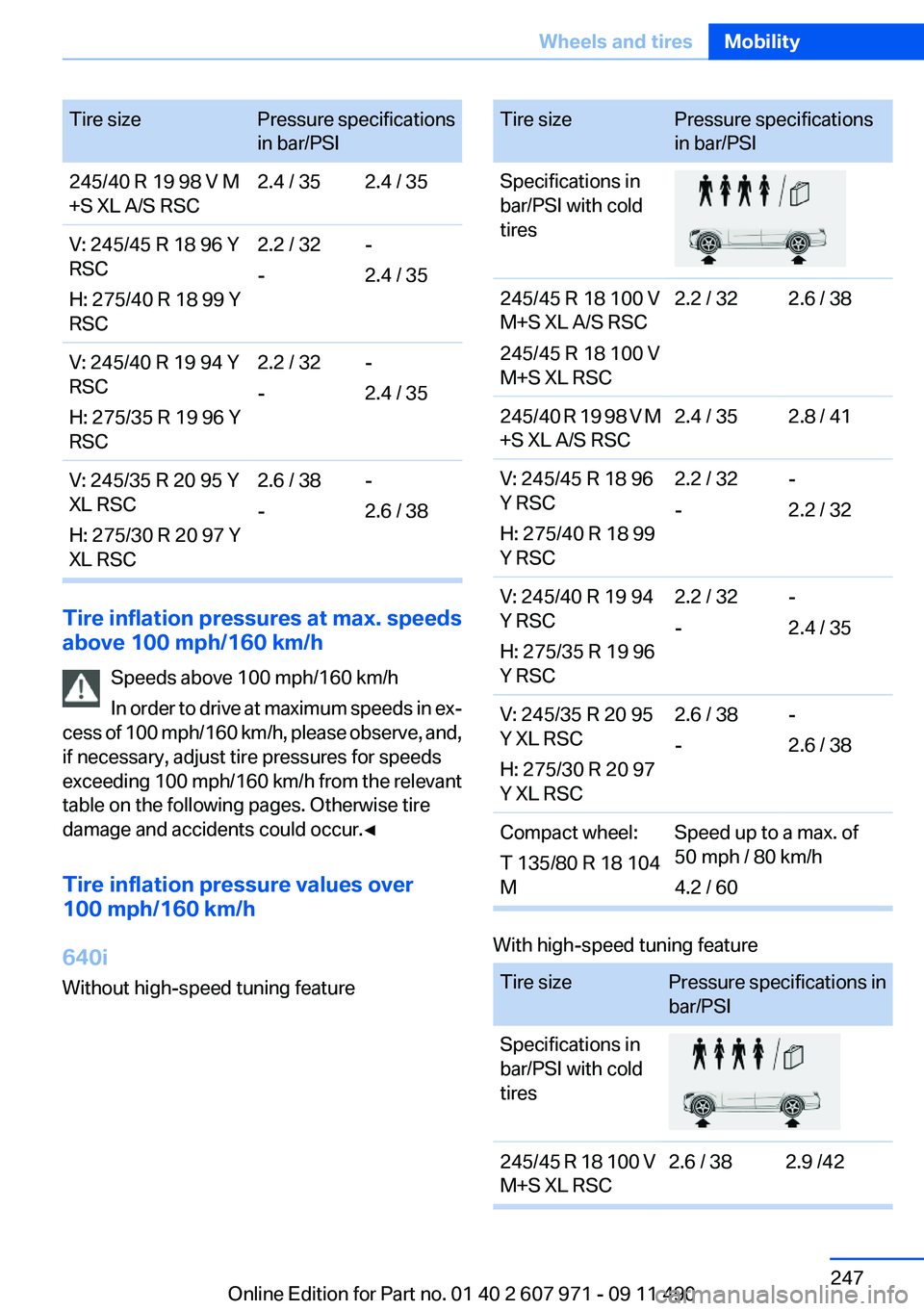
Tire sizePressure specifications
in bar/PSI245/40 R 19 98 V M
+S XL A/S RSC2.4 / 352.4 / 35V: 245/45 R 18 96 Y
RSC
H: 275/40 R 18 99 Y
RSC2.2 / 32
--
2.4 / 35V: 245/40 R 19 94 Y
RSC
H: 275/35 R 19 96 Y
RSC2.2 / 32
--
2.4 / 35V: 245/35 R 20 95 Y
XL RSC
H: 275/30 R 20 97 Y
XL RSC2.6 / 38
--
2.6 / 38
Tire inflation pressures at max. speeds
above 100 mph/160 km/h
Speeds above 100 mph/160 km/h
In order to drive at maximum speeds in ex‐
cess of 100 mph/160 km/h, please observe, and,
if necessary, adjust tire pressures for speeds
exceeding 100 mph/160 km/h from the relevant
table on the following pages. Otherwise tire
damage and accidents could occur.◀
Tire inflation pressure values over
100 mph/160 km/h
640i
Without high-speed tuning feature
Tire sizePressure specifications
in bar/PSISpecifications in
bar/PSI with cold
tires245/45 R 18 100 V
M+S XL A/S RSC
245/45 R 18 100 V
M+S XL RSC2.2 / 322.6 / 38245/40 R 19 98 V M
+S XL A/S RSC2.4 / 352.8 / 41V: 245/45 R 18 96
Y RSC
H: 275/40 R 18 99
Y RSC2.2 / 32
--
2.2 / 32V: 245/40 R 19 94
Y RSC
H: 275/35 R 19 96
Y RSC2.2 / 32
--
2.4 / 35V: 245/35 R 20 95
Y XL RSC
H: 275/30 R 20 97
Y XL RSC2.6 / 38
--
2.6 / 38Compact wheel:
T 135/80 R 18 104
MSpeed up to a max. of
50 mph / 80 km/h
4.2 / 60
With high-speed tuning feature
Tire sizePressure specifications in
bar/PSISpecifications in
bar/PSI with cold
tires245/45 R 18 100 V
M+S XL RSC2.6 / 382.9 /42Seite 247Wheels and tiresMobility247
Online Edition for Part no. 01 40 2 607 971 - 09 11 490
Page 248 of 303
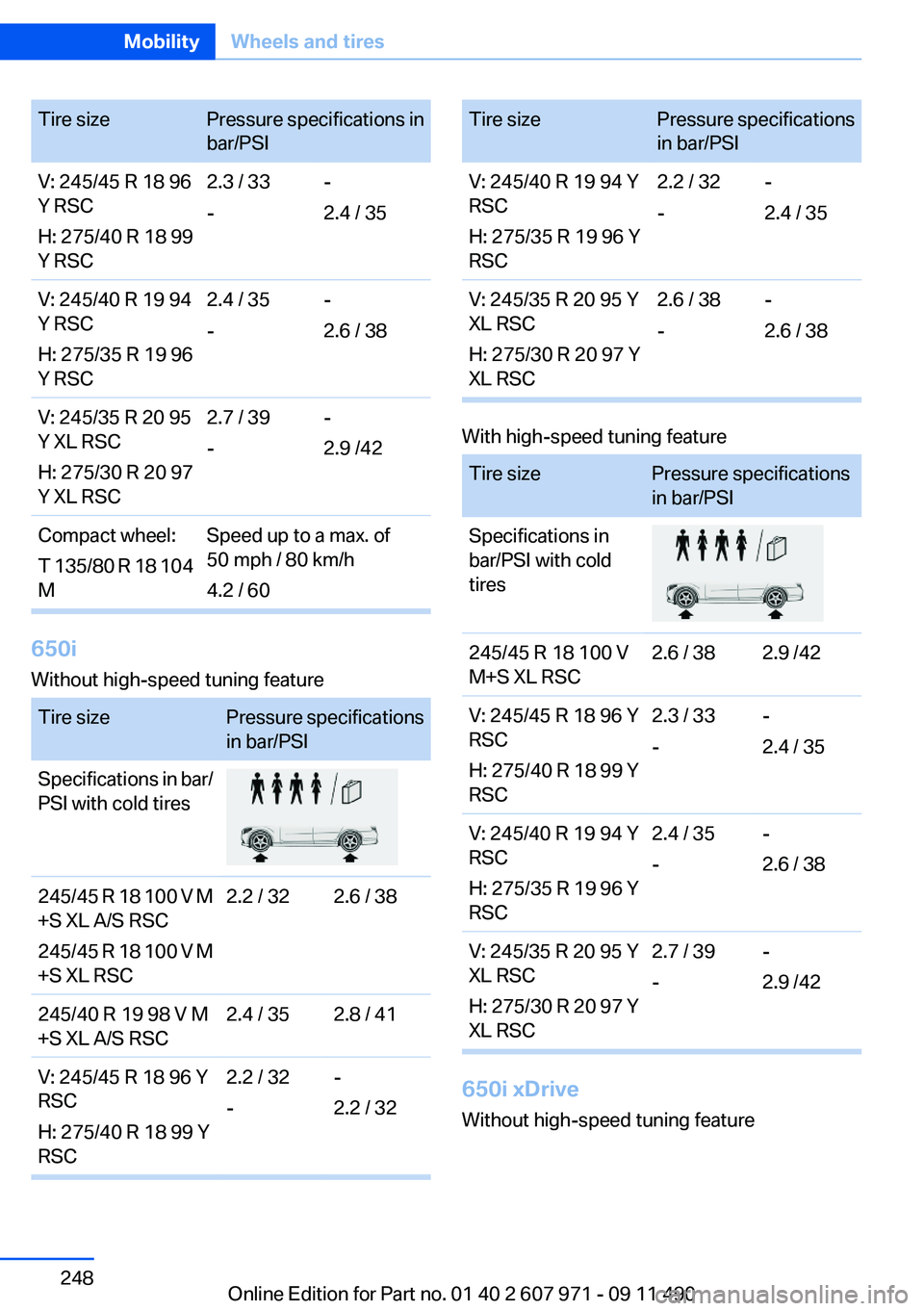
Tire sizePressure specifications in
bar/PSIV: 245/45 R 18 96
Y RSC
H: 275/40 R 18 99
Y RSC2.3 / 33
--
2.4 / 35V: 245/40 R 19 94
Y RSC
H: 275/35 R 19 96
Y RSC2.4 / 35
--
2.6 / 38V: 245/35 R 20 95
Y XL RSC
H: 275/30 R 20 97
Y XL RSC2.7 / 39
--
2.9 /42Compact wheel:
T 135/80 R 18 104
MSpeed up to a max. of
50 mph / 80 km/h
4.2 / 60
650i
Without high-speed tuning feature
Tire sizePressure specifications
in bar/PSISpecifications in bar/
PSI with cold tires245/45 R 18 100 V M
+S XL A/S RSC
245/45 R 18 100 V M
+S XL RSC2.2 / 322.6 / 38245/40 R 19 98 V M
+S XL A/S RSC2.4 / 352.8 / 41V: 245/45 R 18 96 Y
RSC
H: 275/40 R 18 99 Y
RSC2.2 / 32
--
2.2 / 32Tire sizePressure specifications
in bar/PSIV: 245/40 R 19 94 Y
RSC
H: 275/35 R 19 96 Y
RSC2.2 / 32
--
2.4 / 35V: 245/35 R 20 95 Y
XL RSC
H: 275/30 R 20 97 Y
XL RSC2.6 / 38
--
2.6 / 38
With high-speed tuning feature
Tire sizePressure specifications
in bar/PSISpecifications in
bar/PSI with cold
tires245/45 R 18 100 V
M+S XL RSC2.6 / 382.9 /42V: 245/45 R 18 96 Y
RSC
H: 275/40 R 18 99 Y
RSC2.3 / 33
--
2.4 / 35V: 245/40 R 19 94 Y
RSC
H: 275/35 R 19 96 Y
RSC2.4 / 35
--
2.6 / 38V: 245/35 R 20 95 Y
XL RSC
H: 275/30 R 20 97 Y
XL RSC2.7 / 39
--
2.9 /42
650i xDrive
Without high-speed tuning feature
Seite 248MobilityWheels and tires248
Online Edition for Part no. 01 40 2 607 971 - 09 11 490
Page 249 of 303
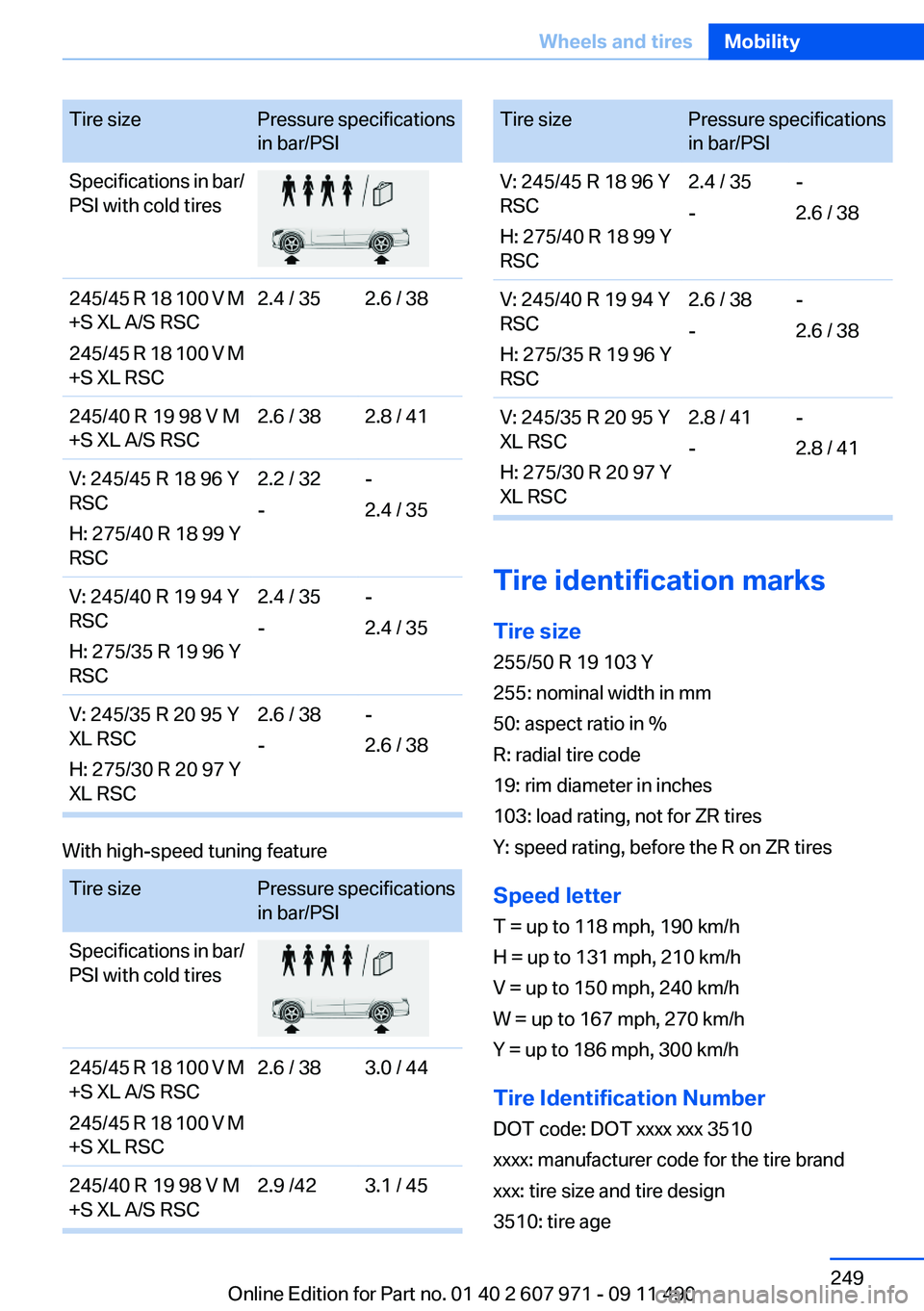
Tire sizePressure specifications
in bar/PSISpecifications in bar/
PSI with cold tires245/45 R 18 100 V M
+S XL A/S RSC
245/45 R 18 100 V M
+S XL RSC2.4 / 352.6 / 38245/40 R 19 98 V M
+S XL A/S RSC2.6 / 382.8 / 41V: 245/45 R 18 96 Y
RSC
H: 275/40 R 18 99 Y
RSC2.2 / 32
--
2.4 / 35V: 245/40 R 19 94 Y
RSC
H: 275/35 R 19 96 Y
RSC2.4 / 35
--
2.4 / 35V: 245/35 R 20 95 Y
XL RSC
H: 275/30 R 20 97 Y
XL RSC2.6 / 38
--
2.6 / 38
With high-speed tuning feature
Tire sizePressure specifications
in bar/PSISpecifications in bar/
PSI with cold tires245/45 R 18 100 V M
+S XL A/S RSC
245/45 R 18 100 V M
+S XL RSC2.6 / 383.0 / 44245/40 R 19 98 V M
+S XL A/S RSC2.9 /423.1 / 45Tire sizePressure specifications
in bar/PSIV: 245/45 R 18 96 Y
RSC
H: 275/40 R 18 99 Y
RSC2.4 / 35
--
2.6 / 38V: 245/40 R 19 94 Y
RSC
H: 275/35 R 19 96 Y
RSC2.6 / 38
--
2.6 / 38V: 245/35 R 20 95 Y
XL RSC
H: 275/30 R 20 97 Y
XL RSC2.8 / 41
--
2.8 / 41
Tire identification marks
Tire size
255/50 R 19 103 Y
255: nominal width in mm
50: aspect ratio in %
R: radial tire code
19: rim diameter in inches
103: load rating, not for ZR tires
Y: speed rating, before the R on ZR tires
Speed letter
T = up to 118 mph, 190 km/h
H = up to 131 mph, 210 km/h
V = up to 150 mph, 240 km/h
W = up to 167 mph, 270 km/h
Y = up to 186 mph, 300 km/h
Tire Identification Number
DOT code: DOT xxxx xxx 3510
xxxx: manufacturer code for the tire brand
xxx: tire size and tire design
3510: tire age
Seite 249Wheels and tiresMobility249
Online Edition for Part no. 01 40 2 607 971 - 09 11 490
Page 252 of 303
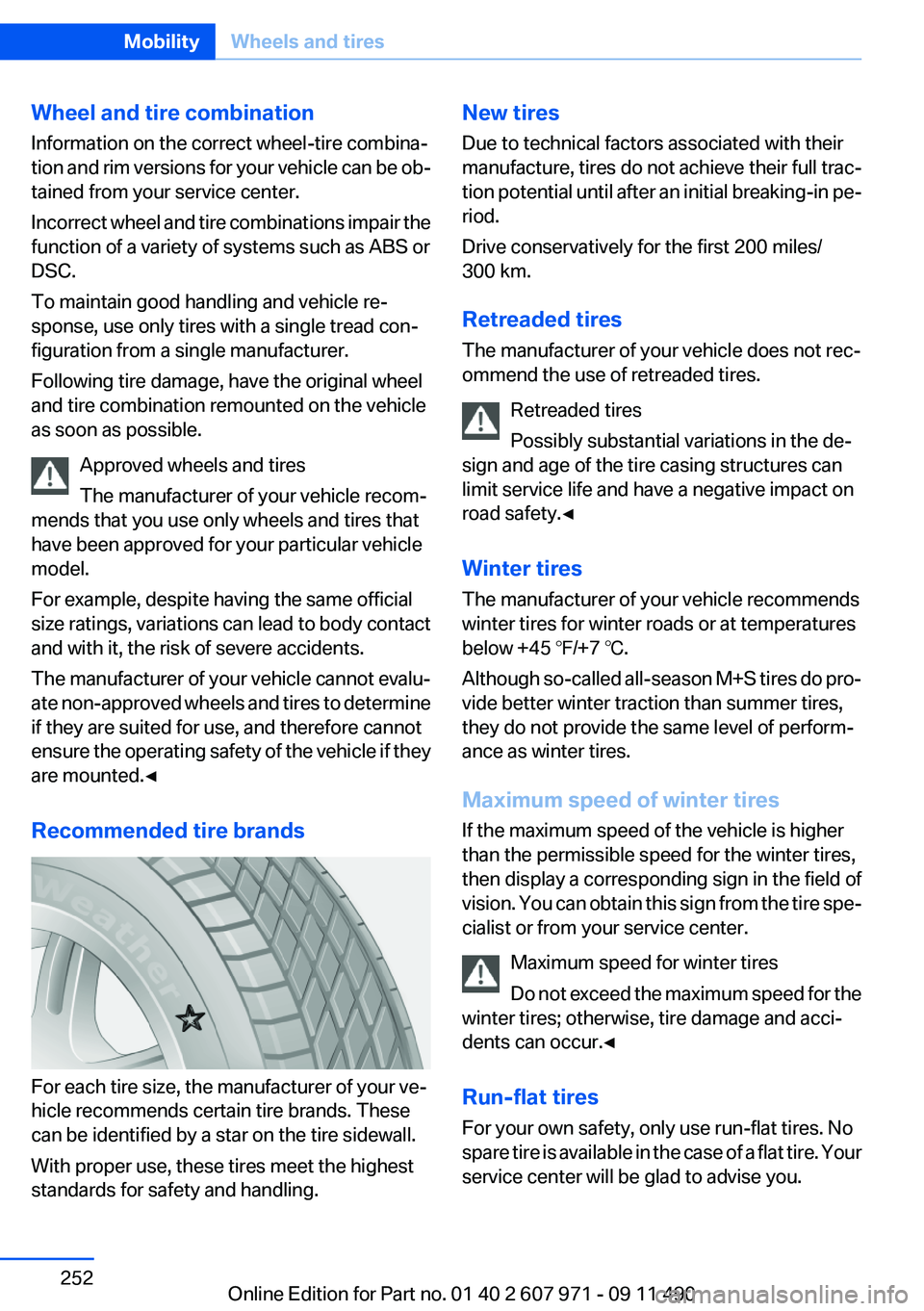
Wheel and tire combination
Information on the correct wheel-tire combina‐
tion and rim versions for your vehicle can be ob‐
tained from your service center.
Incorrect wheel and tire combinations impair the
function of a variety of systems such as ABS or
DSC.
To maintain good handling and vehicle re‐
sponse, use only tires with a single tread con‐
figuration from a single manufacturer.
Following tire damage, have the original wheel
and tire combination remounted on the vehicle
as soon as possible.
Approved wheels and tires
The manufacturer of your vehicle recom‐
mends that you use only wheels and tires that
have been approved for your particular vehicle
model.
For example, despite having the same official
size ratings, variations can lead to body contact
and with it, the risk of severe accidents.
The manufacturer of your vehicle cannot evalu‐
ate non-approved wheels and tires to determine
if they are suited for use, and therefore cannot
ensure the operating safety of the vehicle if they
are mounted.◀
Recommended tire brands
For each tire size, the manufacturer of your ve‐
hicle recommends certain tire brands. These
can be identified by a star on the tire sidewall.
With proper use, these tires meet the highest
standards for safety and handling.
New tires
Due to technical factors associated with their
manufacture, tires do not achieve their full trac‐
tion potential until after an initial breaking-in pe‐
riod.
Drive conservatively for the first 200 miles/
300 km.
Retreaded tires
The manufacturer of your vehicle does not rec‐
ommend the use of retreaded tires.
Retreaded tires
Possibly substantial variations in the de‐
sign and age of the tire casing structures can
limit service life and have a negative impact on
road safety.◀
Winter tires
The manufacturer of your vehicle recommends
winter tires for winter roads or at temperatures
below +45 ℉/+7 ℃.
Although so-called all-season M+S tires do pro‐
vide better winter traction than summer tires,
they do not provide the same level of perform‐
ance as winter tires.
Maximum speed of winter tires
If the maximum speed of the vehicle is higher
than the permissible speed for the winter tires,
then display a corresponding sign in the field of
vision. You can obtain this sign from the tire spe‐
cialist or from your service center.
Maximum speed for winter tires
Do not exceed the maximum speed for the
winter tires; otherwise, tire damage and acci‐
dents can occur.◀
Run-flat tires
For your own safety, only use run-flat tires. No
spare tire is available in the case of a flat tire. Your
service center will be glad to advise you.Seite 252MobilityWheels and tires252
Online Edition for Part no. 01 40 2 607 971 - 09 11 490
Page 253 of 303
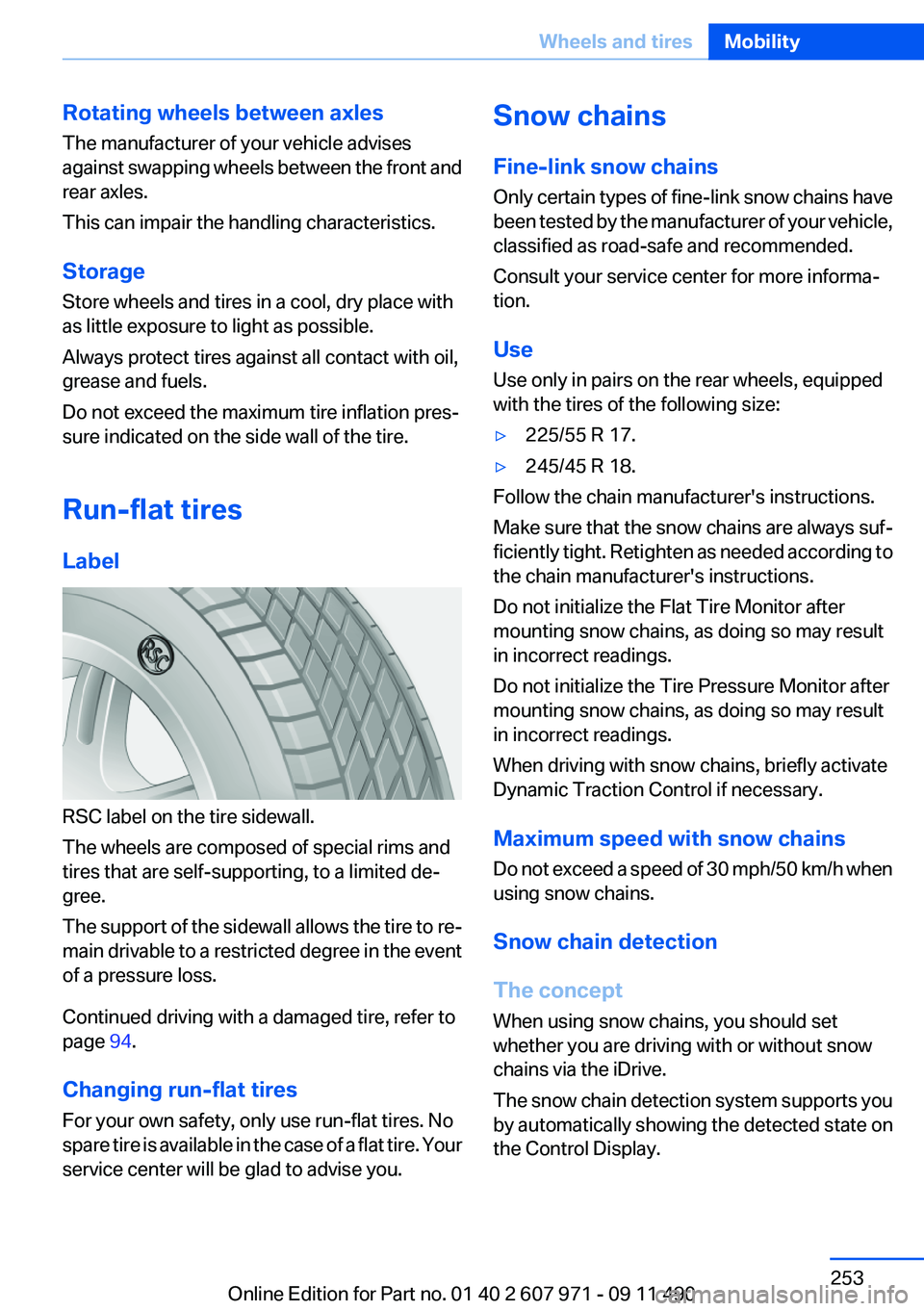
Rotating wheels between axles
The manufacturer of your vehicle advises
against swapping wheels between the front and
rear axles.
This can impair the handling characteristics.
Storage
Store wheels and tires in a cool, dry place with
as little exposure to light as possible.
Always protect tires against all contact with oil,
grease and fuels.
Do not exceed the maximum tire inflation pres‐
sure indicated on the side wall of the tire.
Run-flat tires
Label
RSC label on the tire sidewall.
The wheels are composed of special rims and
tires that are self-supporting, to a limited de‐
gree.
The support of the sidewall allows the tire to re‐
main drivable to a restricted degree in the event
of a pressure loss.
Continued driving with a damaged tire, refer to
page 94.
Changing run-flat tires
For your own safety, only use run-flat tires. No
spare tire is available in the case of a flat tire. Your
service center will be glad to advise you.
Snow chains
Fine-link snow chains
Only certain types of fine-link snow chains have
been tested by the manufacturer of your vehicle,
classified as road-safe and recommended.
Consult your service center for more informa‐
tion.
Use
Use only in pairs on the rear wheels, equipped
with the tires of the following size:▷225/55 R 17.▷245/45 R 18.
Follow the chain manufacturer's instructions.
Make sure that the snow chains are always suf‐
ficiently tight. Retighten as needed according to
the chain manufacturer's instructions.
Do not initialize the Flat Tire Monitor after
mounting snow chains, as doing so may result
in incorrect readings.
Do not initialize the Tire Pressure Monitor after
mounting snow chains, as doing so may result
in incorrect readings.
When driving with snow chains, briefly activate
Dynamic Traction Control if necessary.
Maximum speed with snow chains
Do not exceed a speed of 30 mph/50 km/h when
using snow chains.
Snow chain detection
The concept
When using snow chains, you should set
whether you are driving with or without snow
chains via the iDrive.
The snow chain detection system supports you
by automatically showing the detected state on
the Control Display.
Seite 253Wheels and tiresMobility253
Online Edition for Part no. 01 40 2 607 971 - 09 11 490
Page 299 of 303
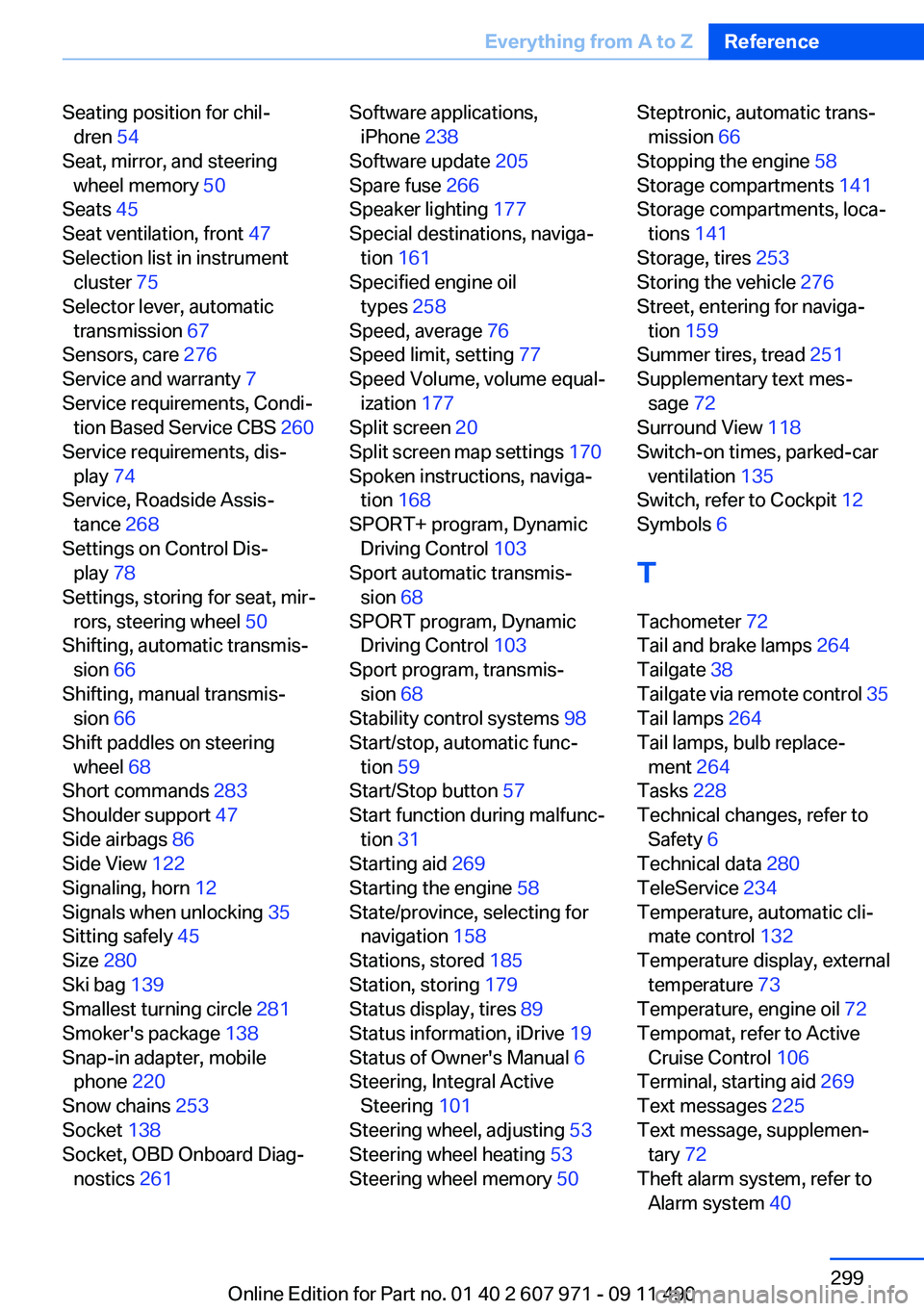
Seating position for chil‐dren 54
Seat, mirror, and steering wheel memory 50
Seats 45
Seat ventilation, front 47
Selection list in instrument cluster 75
Selector lever, automatic transmission 67
Sensors, care 276
Service and warranty 7
Service requirements, Condi‐ tion Based Service CBS 260
Service requirements, dis‐ play 74
Service, Roadside Assis‐ tance 268
Settings on Control Dis‐ play 78
Settings, storing for seat, mir‐ rors, steering wheel 50
Shifting, automatic transmis‐ sion 66
Shifting, manual transmis‐ sion 66
Shift paddles on steering wheel 68
Short commands 283
Shoulder support 47
Side airbags 86
Side View 122
Signaling, horn 12
Signals when unlocking 35
Sitting safely 45
Size 280
Ski bag 139
Smallest turning circle 281
Smoker's package 138
Snap-in adapter, mobile phone 220
Snow chains 253
Socket 138
Socket, OBD Onboard Diag‐ nostics 261 Software applications,
iPhone 238
Software update 205
Spare fuse 266
Speaker lighting 177
Special destinations, naviga‐ tion 161
Specified engine oil types 258
Speed, average 76
Speed limit, setting 77
Speed Volume, volume equal‐ ization 177
Split screen 20
Split screen map settings 170
Spoken instructions, naviga‐ tion 168
SPORT+ program, Dynamic Driving Control 103
Sport automatic transmis‐ sion 68
SPORT program, Dynamic Driving Control 103
Sport program, transmis‐ sion 68
Stability control systems 98
Start/stop, automatic func‐ tion 59
Start/Stop button 57
Start function during malfunc‐ tion 31
Starting aid 269
Starting the engine 58
State/province, selecting for navigation 158
Stations, stored 185
Station, storing 179
Status display, tires 89
Status information, iDrive 19
Status of Owner's Manual 6
Steering, Integral Active Steering 101
Steering wheel, adjusting 53
Steering wheel heating 53
Steering wheel memory 50 Steptronic, automatic trans‐
mission 66
Stopping the engine 58
Storage compartments 141
Storage compartments, loca‐ tions 141
Storage, tires 253
Storing the vehicle 276
Street, entering for naviga‐ tion 159
Summer tires, tread 251
Supplementary text mes‐ sage 72
Surround View 118
Switch-on times, parked-car ventilation 135
Switch, refer to Cockpit 12
Symbols 6
T
Tachometer 72
Tail and brake lamps 264
Tailgate 38
Tailgate via remote control 35
Tail lamps 264
Tail lamps, bulb replace‐ ment 264
Tasks 228
Technical changes, refer to Safety 6
Technical data 280
TeleService 234
Temperature, automatic cli‐ mate control 132
Temperature display, external temperature 73
Temperature, engine oil 72
Tempomat, refer to Active Cruise Control 106
Terminal, starting aid 269
Text messages 225
Text message, supplemen‐ tary 72
Theft alarm system, refer to Alarm system 40 Seite 299Everything from A to ZReference299
Online Edition for Part no. 01 40 2 607 971 - 09 11 490